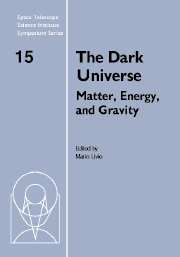Book contents
- Frontmatter
- Contents
- Participants
- Preface
- A brief history of dark matter
- Microlensing towards the Magellanic Clouds: Nature of the lenses and implications on dark matter
- Searching for the Galactic dark matter
- Hot gas in clusters of galaxies and ΩM
- Tracking the baryon density from the Big Bang to the present
- Modified Newtonian Dynamics and its implications
- Cosmological parameters and quintessence from radio galaxies
- The mass density of the Universe
- Growth of structure in the Universe
- Cosmological implications of the most distant supernova (known)
- Dynamical probes of the Halo Mass Function
- Detection of gravitational waves from inflation
- Cosmological constant problems and their solutions
- Dark matter and dark energy: A physicist's perspective
Growth of structure in the Universe
Published online by Cambridge University Press: 21 August 2009
- Frontmatter
- Contents
- Participants
- Preface
- A brief history of dark matter
- Microlensing towards the Magellanic Clouds: Nature of the lenses and implications on dark matter
- Searching for the Galactic dark matter
- Hot gas in clusters of galaxies and ΩM
- Tracking the baryon density from the Big Bang to the present
- Modified Newtonian Dynamics and its implications
- Cosmological parameters and quintessence from radio galaxies
- The mass density of the Universe
- Growth of structure in the Universe
- Cosmological implications of the most distant supernova (known)
- Dynamical probes of the Halo Mass Function
- Detection of gravitational waves from inflation
- Cosmological constant problems and their solutions
- Dark matter and dark energy: A physicist's perspective
Summary
The simplest models for the formation of large-scale structure are reviewed. On the assumption that the dark matter is cold and collisionless, LSS data are able to measure the total amount of matter, together with the baryon fraction and the spectral index of primordial fluctuations. There are degeneracies between these parameters, but these are broken by the addition of extra information such as CMB fluctuation data. The CDM models are confronted with recent data, especially the 2dF Galaxy Redshift Survey, which was the first to measure more than 100,000 redshifts. The 2dFGRS power spectrum is measured to ≲ 10% accuracy for k > 0.02 h Mpc–1, and is well fitted by a CDM model with Ωmh = 0.20 ± 0.03 and a baryon fraction of 0.15 ± 0.07. In combination with CMB data, a flat universe with Ωm ⋍ 0.3 is strongly favored. In order to use LSS data in this way, an understanding of galaxy bias is required. A recent approach to bias, known as the ‘halo model’ allows important insights into this phenomenon, and gives a calculation of the extent to which bias can depend on scale.
Structure formation in the CDM model
The origin and formation of large-scale structure in cosmology is a key problem that has generated much work over the years. Out of all the models that have been proposed, this talk concentrates on the simplest: gravitational instability of small initial density fluctuations.
- Type
- Chapter
- Information
- The Dark UniverseMatter, Energy and Gravity, pp. 102 - 122Publisher: Cambridge University PressPrint publication year: 2004



